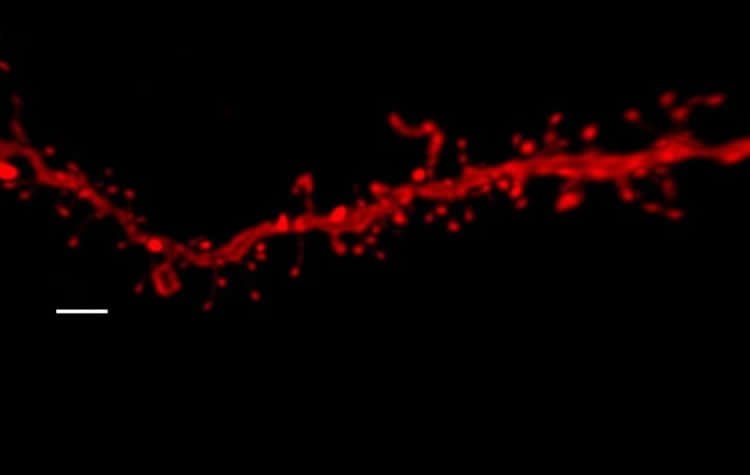Summary: A new study reports exposure to cannabis and stress during the teenage years may result in an increased risk of developing anxiety disorders later in life.
Source: UPF Barcelona.
A new study conducted on laboratory animals shows that exposure to cannabis and stress during adolescence may lead to long-term anxiety disorders characterized by the presence of pathological fear. The work carried out by the Neuropharmacology Laboratory-NeuroPhar at Pompeu Fabra University, was led by the researchers Fernando Berrendero, now at Francisco de Vitoria University, and Rafael Maldonado, and has been published in the journal Neuropharmacology.
Cannabis remains the most commonly consumed illegal drug worldwide. Its regular use often begins during adolescence, which is especially troubling because this period is crucial for the brain to mature properly through the reorganization of the neuronal synapses.
Numerous preclinical and epidemiological data suggest that exposure to cannabinoids in adolescents may increase the risk of the onset of psychiatric illnesses in adulthood. The results of the National Drugs Plan show an increase in the consumption of cannabis and a recent review highlights that in recent years the perception of the risk of its consumption has diminished among the young population, from 12 to 17 years of age, the age group discussed in this article.
“In this study we have investigated the effects of simultaneous exposure to Δ9-tetrahydrocannabinol (THC), which is primarily responsible for the psychoactive properties of cannabis, and to stress during adolescence”, explain Rocio Saravia and Marc Ten-Blanco, first authors of the article. Specifically, they have studied how this exposure during adolescence affects the extinction of the memory of fear in adult mice.

Occasionally, a stimulus that should be neutral, as could be, for example, seeing the dentist in a white coat, is associated with a threatening one, which would be the pain we have felt upon previous visits to the dentist, and causes a fear response. Normally, fear reactions diminish over time as the conditioned stimulus ceases to be associated with the negative experience. This is known as fear extinction. But when fear extinction does not occur properly, anxiety disorders such as post-traumatic stress syndrome, phobias or panic attacks occur.
“We have observed that adolescent mice treated with THC and exposed to stress display impaired fear extinction in adulthood. However, this effect was not observed in animals exposed to these same two factors separately”, Fernando Berrendero explains. In addition, the resistance to fear extinction was associated with a decrease in neuronal activity in the basolateral amygdala and the infralimbic prefrontal cortex, suggesting a deregulation in the long term of the circuit that regulates fear.
“Our findings highlight the influence of environmental factors such as stress on the harmful effects of the exposure to cannabis during early ages and suggest that the consequences of early cannabis use greatly depend on the environment of its use”, explains Rafael Maldonado, full professor of Pharmacology at UPF. “The presence of stress situations, common among consumers of the substance, may worsen the harmful effects of cannabis”, he concludes.
Funding: The article is part of a project funded by the Spanish National Drugs Plan.
Their study has also involved the researchers Humberto Gagliano, Antonio Armario and Raül Andero, of the Autonomous University of Barcelona.
Source: Mari Carmen Cebrián – UPF Barcelona
Publisher: Organized by NeuroscienceNews.com.
Image Source: NeuroscienceNews.com image is credited to UPF.
Original Research: Open access research for “Concomitant THC and stress adolescent exposure induces impaired fear extinction and related neurobiological changes in adulthood” by Rocio Saravia, Marc Ten-Blanco, Marina Julià-Hernández, Humberto Gagliano, Raül Andero, Antonio Armario, Rafae lMaldonado, and Fernando Berrendero in Neuropharmacology. Published November 12 2018.
doi:10.1016/j.neuropharm.2018.11.016
[cbtabs][cbtab title=”MLA”]UPF Barcelona”How the Brain Decides Whether to Hold ’em or Fold ’em.” NeuroscienceNews. NeuroscienceNews, 7 January 2019.
<https://neurosciencenews.com/anxiety-cannabis-stress-10458/>.[/cbtab][cbtab title=”APA”]UPF Barcelona(2019, January 7). How the Brain Decides Whether to Hold ’em or Fold ’em. NeuroscienceNews. Retrieved January 7, 2019 from https://neurosciencenews.com/anxiety-cannabis-stress-10458/[/cbtab][cbtab title=”Chicago”]UPF Barcelona”How the Brain Decides Whether to Hold ’em or Fold ’em.” https://neurosciencenews.com/anxiety-cannabis-stress-10458/ (accessed January 7, 2019).[/cbtab][/cbtabs]
Abstract
Concomitant THC and stress adolescent exposure induces impaired fear extinction and related neurobiological changes in adulthood
Δ9-tetrahydrocannabinol (THC) consumption during adolescence is reported to be a risk factor for the appearance of psychiatric disorders later in life. The interaction between genetic or environmental events and cannabinoid exposure in the adolescent period can also contribute to exacerbate behavioural deficits in adulthood. Here we investigate the effects of THC treatment as well as the consequences of concomitant THC and stress exposure during adolescence in the extinction of fear memory in adult mice. Adolescent mice treated with THC and exposed to stress exhibit impaired cued fear extinction in adulthood. However, no effect was observed in animals exposed to these two factors separately. Notably, resistance to fear extinction was associated with decreased neuronal activity in the basolateral amygdala (BLA) and the infralimbic prefrontal cortex, suggesting a long-term dysregulation of the fear circuit. These changes in neuronal activation were paralleled with structural plasticity alterations. Indeed, an increase of immature dendritic spines in pyramidal neurons of the BLA was revealed in mice simultaneously exposed to THC and stress. Corticosterone levels were also enhanced after the cued fear conditioning session in the same experimental group. These results show that an interaction between cannabis exposure and stress during adolescence may lead to long-term anxiety disorders characterized by the presence of pathological fear.






